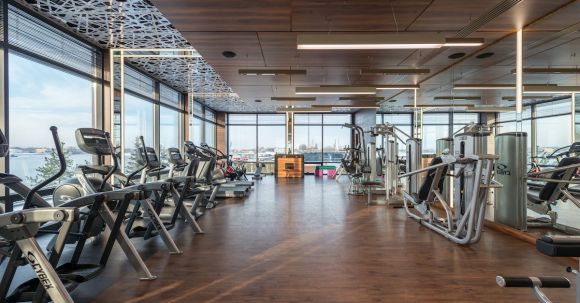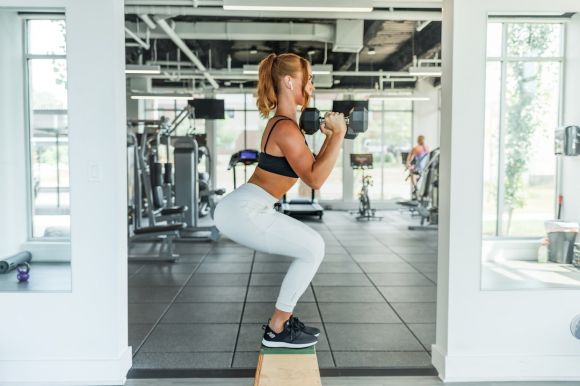Cardio workouts are an essential part of any fitness routine. They help to improve cardiovascular health, burn calories, and boost overall fitness levels. However, for many people, cardio workouts can become monotonous and boring, leading to a lack of motivation and enjoyment. The good news is that there are several ways to make cardio workouts more fun and enjoyable. In this article, we will explore some practical tips to help you spice up your cardio routine and keep the excitement alive.
Cardiovascular exercises
Cardiovascular exercise, also known as cardio, is a form of physical activity that gets your heart rate up and improves overall fitness. It is an essential component of any workout routine and offers numerous health benefits. Whether you're a beginner or an experienced exerciser, it's important to know how to maximize the effectiveness of your cardio workouts. In this article, we will discuss some key strategies to help you get the most out of your cardio sessions.
Choose the Right Type of Cardio
There are various types of cardio exercises to choose from, such as running, cycling, swimming, and dancing. It's important to select an activity that you enjoy and that suits your fitness level. This will help you stay motivated and committed to your workouts. Experiment with different types of cardio to find what you enjoy the most and what challenges you physically.Set Clear Goals
Setting clear goals is crucial for making progress in your cardio workouts. Whether you want to improve your endurance, lose weight, or train for a specific event, having a clear objective in mind will help you stay focused and motivated. Set both short-term and long-term goals and track your progress regularly. This will allow you to celebrate your achievements and make adjustments to your workouts as needed.Warm Up Properly
Before starting any cardio workout, it's important to warm up your body properly. This helps increase blood flow to your muscles, improves flexibility, and reduces the risk of injury. Start with some light aerobic exercises, such as jogging in place or jumping jacks, for at least five minutes. Then, proceed to dynamic stretches that target the major muscle groups you'll be using during your cardio workout.Mix Up Intensity Levels
To get the most out of your cardio workouts, it's important to vary the intensity levels. Incorporate both low-intensity and high-intensity intervals into your training. Low-intensity exercises, such as brisk walking or slow cycling, are great for building endurance and burning calories. High-intensity exercises, such as sprinting or interval training, help improve cardiovascular fitness and increase calorie burn.Use Interval Training
Interval training is a highly effective way to maximize your cardio workouts. It involves alternating between periods of high-intensity exercise and periods of recovery. For example, you could sprint for 30 seconds and then walk or jog for one minute. Repeat this cycle for a total of 10-15 minutes. Interval training boosts your metabolism, increases fat burning, and improves cardiovascular fitness in a shorter amount of time.Monitor Your Heart Rate
Monitoring your heart rate during cardio workouts is a great way to gauge your intensity level and ensure you're working at an appropriate pace. To determine your target heart rate, subtract your age from 220 and multiply the result by 0.6 and 0.8. During your workouts, periodically check your heart rate and adjust the intensity as needed to stay within your target range.Fuel Your Body Properly
Proper nutrition is essential for getting the most out of your cardio workouts. Before exercising, fuel your body with a balanced meal or snack that includes carbohydrates for energy and protein for muscle repair. After your workout, replenish your body with a combination of protein and carbohydrates to aid in recovery. Stay hydrated throughout your workouts by drinking water before, during, and after exercise.Stay Consistent
Consistency is key when it comes to getting the most out of your cardio workouts. Aim for at least 150 minutes of moderate-intensity cardio or 75 minutes of vigorous-intensity cardio per week. Break it down into smaller, manageable sessions that fit your schedule. Remember, even short bursts of activity can add up and contribute to your overall fitness.Conclusion
By choosing the right type of cardio, setting clear goals, warming up properly, varying intensity levels, using interval training, monitoring your heart rate, fueling your body properly, and staying consistent, you can maximize the effectiveness of your cardio workouts. Remember to listen to your body, take rest days when needed, and have fun while exercising. With these strategies in place, you'll be well on your way to achieving your fitness goals and reaping the many benefits of cardiovascular exercise.
Cardio workouts are an excellent way to improve your cardiovascular health, burn calories, and boost your overall fitness level. However, staying motivated during these workouts can be a challenge, especially if you find them monotonous or if you struggle with maintaining a consistent routine. Fortunately, there are several strategies you can employ to stay motivated and make the most out of your cardio sessions.
Set Clear Goals
Setting clear goals is crucial for staying motivated during cardio workouts. Without a clear objective, it can be easy to lose focus and become demotivated. Start by defining your goals, whether it's running a certain distance, improving your endurance, or losing a specific amount of weight. Write them down and keep them visible as a constant reminder of what you're working towards.Create a Playlist
Music has a powerful impact on our mood and can significantly enhance our workout experience. Creating a high-energy playlist filled with your favorite songs can provide a much-needed boost of motivation during cardio workouts. Choose songs with a fast tempo that make you feel energized and ready to push through any fatigue. Consider updating your playlist regularly to keep it fresh and exciting.Try Interval Training
Interval training is an effective way to keep your cardio workouts engaging and prevent boredom. Instead of maintaining a steady pace throughout your entire workout, alternate between periods of high-intensity exercise and lower-intensity recovery periods. This not only challenges your body but also keeps your mind engaged as you focus on the changing intervals. Experiment with different interval lengths and intensities to find what works best for you.Mix Up Your Routine
Repeating the same cardio workout day after day can quickly lead to boredom and demotivation. To combat this, mix up your routine by trying different activities or variations of your favorite exercises. If you enjoy running, try incorporating sprints or hill intervals into your routine. If you prefer indoor workouts, consider trying different cardio machines or taking a dance class. The key is to keep your workouts fresh and exciting to maintain your motivation.Find a Workout Buddy
Having a workout buddy can significantly increase your motivation and make cardio workouts more enjoyable. Choose someone who shares similar fitness goals and schedule regular workout sessions together. Not only will you have someone to hold you accountable, but you'll also have someone to share the experience with. Working out with a friend can make the time go by faster and provide an extra level of support and encouragement.Track Your Progress
Tracking your progress is essential for staying motivated during cardio workouts. Keep a record of your workouts, including the duration, distance, and any other relevant metrics. This will allow you to see your improvements over time and provide a sense of accomplishment. Additionally, consider using fitness apps or wearable devices that track your heart rate, calories burned, and other valuable data. These tools can provide real-time feedback and help you stay motivated as you see your progress unfold.Reward Yourself
Rewarding yourself can be a powerful motivator to keep pushing through your cardio workouts. Set small milestones along the way and reward yourself when you achieve them. It could be treating yourself to a massage, buying new workout gear, or enjoying a guilt-free cheat meal. Just make sure your rewards align with your fitness goals and don't undermine your progress. In conclusion, staying motivated during cardio workouts is crucial for achieving your fitness goals. By setting clear goals, creating an inspiring playlist, trying interval training, mixing up your routine, finding a workout buddy, tracking your progress, and rewarding yourself, you can stay motivated and make the most out of your cardio workouts. Remember, consistency is key, so keep pushing through even when motivation is low, and you'll reap the rewards of your hard work.
Cardio workouts are a great way to burn calories and improve cardiovascular fitness. Whether you enjoy running, cycling, dancing, or any other form of aerobic exercise, there are several strategies you can use to maximize your calorie burn and get the most out of your cardio sessions. In this article, we will explore some effective tips to help you achieve your fitness goals.
Choose High-Intensity Interval Training (HIIT)
High-intensity interval training (HIIT) is a type of cardio workout that involves alternating between short bursts of intense exercise and periods of recovery. This method has been shown to be highly effective for calorie burn and can help you achieve results in less time. By pushing your body to its limits during the intense intervals, you can significantly increase your metabolic rate and continue burning calories even after the workout is over.Incorporate Resistance Training
While cardio workouts primarily focus on burning calories, incorporating resistance training into your routine can help you build lean muscle mass. Muscle is more metabolically active than fat, meaning that the more muscle you have, the more calories you will burn at rest. By adding strength training exercises such as weightlifting or bodyweight exercises to your cardio routine, you can increase your overall calorie burn and boost your metabolism.Increase the Intensity of Your Workouts
To maximize calorie burn during your cardio workouts, it is important to continuously challenge yourself and increase the intensity of your exercises. This can be done by increasing the speed, resistance, or incline of your workout equipment, or by incorporating more challenging exercises into your routine. By pushing yourself out of your comfort zone, you will burn more calories and continue to make progress towards your fitness goals.Focus on Full-Body Movements
Engaging multiple muscle groups simultaneously during your cardio workouts can help you burn more calories. Instead of focusing solely on exercises that target a specific muscle group, opt for full-body movements that require the use of multiple muscles. Exercises such as burpees, mountain climbers, or kettlebell swings are excellent choices for engaging the entire body and maximizing calorie burn.Stay Consistent and Vary Your Workouts
Consistency is key when it comes to maximizing calorie burn during cardio workouts. Aim for at least 150 minutes of moderate-intensity cardio exercise or 75 minutes of vigorous-intensity exercise per week. Additionally, it is important to vary your workouts to prevent plateaus and keep your body challenged. Try different types of cardio exercises, alternate between HIIT and steady-state cardio, or join group fitness classes to keep your workouts interesting and effective.Stay Hydrated and Fuel Your Body Properly
Proper hydration and nutrition are essential for maximizing calorie burn during cardio workouts. Dehydration can negatively impact your performance and decrease your ability to burn calories. Aim to drink water before, during, and after your workouts to stay hydrated. Additionally, fueling your body with the right nutrients before and after your cardio sessions can help optimize your performance and recovery. In conclusion, maximizing calorie burn during cardio workouts involves incorporating high-intensity interval training, resistance training, and full-body movements into your routine. By continuously challenging yourself, staying consistent, and fueling your body properly, you can achieve your fitness goals and make the most out of your cardio sessions. So lace up your sneakers, hit the gym, and start maximizing your calorie burn today!
Maintaining a healthy cardiovascular system is essential for overall well-being. Exercise is a powerful tool that can help improve cardiovascular health and reduce the risk of heart disease. By incorporating regular physical activity into your routine, you can strengthen your heart, improve blood circulation, and lower your blood pressure. In this article, we will explore various exercises that are beneficial for your cardiovascular health and provide tips on how to incorporate them into your daily life.
Aerobic Exercises: The Key to a Healthy Heart
Aerobic exercises, also known as cardiovascular exercises, are particularly effective in improving cardiovascular health. These exercises increase your heart rate and make your heart stronger. Some examples of aerobic exercises include walking, jogging, cycling, swimming, and dancing. These activities engage large muscle groups and require continuous movement, making them ideal for improving cardiovascular fitness.The Importance of Moderate Intensity
When engaging in aerobic exercises, it is important to aim for moderate intensity. This means that you should be working hard enough to raise your heart rate and break a sweat, but still be able to carry on a conversation. Moderate-intensity exercises provide a challenging workout for your heart without putting excessive stress on it. By gradually increasing the intensity of your workouts over time, you can continually challenge your cardiovascular system and reap the benefits.Interval Training: A Time-Efficient Option
Interval training is an excellent way to boost cardiovascular fitness in a shorter amount of time. This type of training involves alternating between high-intensity bursts of exercise and periods of rest or low-intensity exercise. For example, you can alternate between sprinting and walking, or cycling at a high intensity for a short period followed by a slower pace. Interval training not only improves cardiovascular health but also helps burn calories and increase endurance.Strength Training: Supporting Cardiovascular Health
While aerobic exercises are essential for cardiovascular health, strength training should not be overlooked. Building muscle strength is important for overall fitness and can indirectly support cardiovascular health. Strength training exercises, such as weightlifting or bodyweight exercises, help increase muscle mass, which in turn increases your metabolism. A higher metabolism helps your body burn more calories, maintain a healthy weight, and reduces the risk of developing heart disease.Incorporating Exercise into Your Daily Life
To improve cardiovascular health, it is important to make exercise a regular part of your daily life. Here are some tips to help you incorporate exercise into your routine: 1. Start with small steps: Begin by incorporating short bouts of physical activity into your day, such as taking the stairs instead of the elevator or going for a short walk during your lunch break. 2. Set achievable goals: Gradually increase the duration and intensity of your workouts. Set realistic goals that you can work towards, such as aiming to exercise for 30 minutes a day, five days a week. 3. Find activities you enjoy: Choose exercises that you enjoy doing to make it easier to stick to your routine. Whether it's dancing, swimming, or playing a sport, finding activities that you find enjoyable will make exercise feel less like a chore. 4. Make it a social activity: Exercise with a friend or join a group fitness class. Having a workout buddy or being part of a community can provide motivation and make exercising more enjoyable. 5. Be consistent: Consistency is key when it comes to improving cardiovascular health. Aim to exercise regularly, even if it's just for a few minutes each day. Consistency will yield long-term benefits for your heart health. In conclusion, exercise plays a crucial role in improving cardiovascular health. By incorporating aerobic exercises, interval training, and strength training into your routine, you can strengthen your heart, improve blood circulation, and lower your blood pressure. Remember to start small, set achievable goals, and make exercise a regular part of your daily life. With consistency and dedication, you can improve your cardiovascular health and enjoy the benefits of a stronger heart.
Cardio workouts, also known as aerobic exercises, are a fantastic way to improve your overall fitness and burn calories. However, many people make common mistakes that can hinder their progress or even lead to injury. In this article, we will discuss some of these mistakes and provide helpful tips on how to avoid them.
Skipping the Warm-up
One of the biggest mistakes people make before starting a cardio workout is skipping the warm-up. A proper warm-up is essential to prepare your body for exercise and prevent injuries. It increases your heart rate gradually, warms up your muscles, and improves joint mobility. Spend at least 5-10 minutes doing light aerobic exercises, such as jogging in place or jumping jacks, before diving into your main workout.Neglecting Proper Form
Maintaining proper form during cardio exercises is crucial to prevent injuries and maximize the effectiveness of your workout. Many people make the mistake of sacrificing form for speed or intensity. For example, when running, avoid slouching or leaning forward, as this can strain your lower back. Instead, focus on keeping your back straight, shoulders relaxed, and arms at a 90-degree angle.Overtraining
While it's important to challenge yourself during cardio workouts, overtraining can do more harm than good. Pushing yourself too hard and too frequently can lead to fatigue, decreased performance, and even overuse injuries. It's crucial to listen to your body and give yourself enough time to recover between workouts. Aim for at least one or two rest days each week to allow your muscles to repair and rebuild.Not Mixing Up Your Routine
Doing the same cardio workout day in and day out can lead to a plateau in your progress and make your workouts feel monotonous. To avoid this, incorporate different types of cardio exercises into your routine. Try activities like swimming, cycling, dancing, or using the elliptical machine. Not only will this keep your workouts interesting, but it will also challenge your body in new ways and target different muscle groups.Ignoring Strength Training
While cardio workouts are excellent for improving cardiovascular health, they may not be enough to achieve your fitness goals. Neglecting strength training is a common mistake many people make. Incorporating strength exercises, such as weightlifting or bodyweight exercises, into your routine can help build lean muscle mass, increase metabolism, and improve overall strength. Aim for at least two days of strength training per week, alternating between upper and lower body exercises.Not Listening to Your Body
Perhaps the most crucial mistake to avoid during cardio workouts is not listening to your body. Pay attention to any pain, discomfort, or unusual sensations during your workout. Pushing through pain can lead to injuries, so it's important to take a break and seek medical attention if needed. Additionally, if you're feeling excessively fatigued or experiencing prolonged muscle soreness, it may be a sign that you need to adjust your workout intensity or take a rest day. In conclusion, cardio workouts are a fantastic way to improve fitness and burn calories. By avoiding common mistakes such as skipping the warm-up, neglecting proper form, overtraining, not mixing up your routine, ignoring strength training, and not listening to your body, you can ensure that your cardio workouts are both safe and effective. Remember to always prioritize your health and well-being when engaging in any form of exercise.
Introduction:
Maintaining good digestive health is essential for overall well-being. An often overlooked aspect of digestion is the role that cardiovascular exercise can play in promoting a healthy gut. While most people associate cardio workouts with weight loss or cardiovascular health, they may not realize the benefits it can have on digestion. In this article, we will explore how cardiovascular exercises can improve digestion and promote gut health.
The Gut-Exercise Connection:
The gut, also known as the gastrointestinal tract, plays a vital role in the digestion and absorption of nutrients. A well-functioning gut ensures that food is broken down properly and nutrients are efficiently absorbed, leading to better overall health. Regular exercise, particularly cardiovascular exercises, can have a positive impact on the gut.
Increased Blood Flow:
One of the key benefits of cardiovascular exercises is the increase in blood flow throughout the body. This increased blood flow also extends to the digestive system, supplying it with oxygen and nutrients needed for optimal function. Improved blood flow can enhance the efficiency of digestion and nutrient absorption, leading to better gut health.
Stimulates Bowel Movements:
Cardio exercises can help stimulate bowel movements, preventing constipation and promoting regularity. The rhythmic movements involved in activities such as running or cycling can help stimulate the muscles of the digestive tract, aiding in the movement of waste through the intestines. Regular bowel movements are essential for maintaining a healthy gut.
Reduces Stress:
Stress can have a detrimental effect on digestion. It can disrupt the balance of bacteria in the gut and lead to digestive issues such as bloating, cramping, and diarrhea. Cardio exercises are known to reduce stress levels by releasing endorphins, the feel-good hormones. By reducing stress, cardiovascular exercises indirectly promote better digestion and gut health.
Improves Gut Microbiota:
The gut is home to trillions of bacteria that make up the gut microbiota. These bacteria play a crucial role in digestion and overall health. Studies have shown that regular exercise can positively influence the composition and diversity of gut microbiota. Cardio exercises help promote the growth of beneficial bacteria while reducing the presence of harmful bacteria, leading to a healthier gut environment.
Enhances Metabolism:
Cardiovascular exercises can boost metabolism, which is the rate at which the body burns calories. A faster metabolism means that food is processed more efficiently, allowing for better digestion and absorption of nutrients. This improved metabolism can also aid in weight management, which is essential for maintaining a healthy gut.
Tips for incorporating Cardiovascular Exercises into your Routine:
1. Start Slow: If you are new to cardiovascular exercises, start with low-impact activities such as walking or swimming. Gradually increase the intensity and duration of your workouts as your fitness level improves.
2. Find an Activity you Enjoy: Choose a cardiovascular exercise that you enjoy doing. Whether it's dancing, cycling, or playing a sport, finding an activity you love will make it easier to stick to your routine.
3. Aim for Regular Exercise: Aim for at least 150 minutes of moderate-intensity cardio exercises per week, or 75 minutes of vigorous-intensity exercises. Breaking it down into smaller sessions throughout the week can make it more manageable.
4. Stay Hydrated: Proper hydration is essential for digestion and overall health. Drink plenty of water before, during, and after your workouts to stay hydrated.
Conclusion:
Cardiovascular exercises offer numerous benefits for improving digestion and promoting gut health. By increasing blood flow, stimulating bowel movements, reducing stress, improving gut microbiota, and enhancing metabolism, cardio workouts can have a positive impact on digestive function. Incorporating regular cardiovascular exercises into your routine, along with a healthy diet, can lead to better digestion and improved overall gut health. So lace up your sneakers and get moving for a healthier gut!
Cardiovascular exercises, also known as cardio exercises, are essential for maintaining a healthy heart and overall fitness. Incorporating these exercises into your daily routine can bring numerous benefits, including improved endurance, weight management, and stress reduction. However, finding the time and motivation to engage in cardio exercises can be challenging. Fortunately, with a little planning and creativity, you can easily include cardio exercises into your daily routine without disrupting your schedule.
1. Start Your Day with a Morning Walk
One of the easiest ways to incorporate cardio exercises into your daily routine is to start your day with a brisk morning walk. Set your alarm a little earlier and take a 20-30 minute walk around your neighborhood. Not only will this get your heart pumping, but it will also invigorate your mind and prepare you for the day ahead.2. Take the Stairs
Instead of relying on elevators or escalators, make it a habit to take the stairs whenever possible. Climbing stairs is an excellent cardio exercise that engages multiple muscle groups and increases your heart rate. Whether you're at work, in a shopping mall, or at home, opt for the stairs and reap the cardiovascular benefits.3. Incorporate Cardio into Your Commute
If you typically commute to work or school using public transportation, consider adding some cardio into your journey. Get off a few stops earlier and walk the remaining distance. Alternatively, if you live close enough, consider biking or jogging to your destination. Not only will this save you money on transportation, but it will also provide you with a daily dose of exercise.4. Make Use of Breaks and Lunch Hours
Instead of sitting at your desk during breaks or lunch hours, make use of this time to engage in quick cardio exercises. Go for a brisk walk around the office building or nearby park, do a few sets of jumping jacks or high knees, or find a quiet space to do some yoga or stretching. These short bursts of cardio can help boost your energy levels and productivity throughout the day.5. Incorporate Cardio into Household Chores
Household chores are often seen as mundane tasks, but they can also be an opportunity to get your heart rate up. Engage in activities such as vacuuming, mopping, or gardening at a faster pace to turn them into cardio exercises. You can also try incorporating squats or lunges while doing chores to engage your leg muscles and increase the intensity.6. Incorporate Cardio into Family Activities
Spending quality time with your family doesn't have to mean sacrificing your cardio routine. Look for activities that the whole family can enjoy while getting their hearts pumping. Go for a bike ride, play a game of tag, or have a dance party in your living room. By involving your loved ones, you not only make exercise more enjoyable but also encourage healthy habits in those around you.7. Find Activities You Enjoy
Lastly, the key to incorporating cardio exercises into your daily routine is to find activities that you genuinely enjoy. Whether it's swimming, dancing, kickboxing, or playing a sport, find something that excites you and makes you look forward to exercising. When you enjoy what you're doing, it becomes easier to stay consistent and make cardio a regular part of your life. In conclusion, incorporating cardio exercises into your daily routine doesn't have to be a daunting task. By making small adjustments and finding creative ways to engage in cardio activities, you can reap the numerous benefits of cardiovascular exercise without disrupting your schedule. Start by taking a morning walk, taking the stairs, or incorporating cardio into your commute. Make use of breaks and lunch hours, turn household chores into cardio exercises, and involve your family in physical activities. Most importantly, find an activity you enjoy to make cardio a sustainable and enjoyable part of your life.
Cholesterol is a fatty substance that is found in the blood. While the body needs cholesterol to build healthy cells, having high levels of cholesterol can increase the risk of heart disease. Regular exercise, particularly cardiovascular exercises, can play a significant role in reducing cholesterol levels and promoting heart health. In this article, we will explore some effective cardiovascular exercises that can help lower cholesterol levels.
Running
Running is a popular and effective cardiovascular exercise that can help reduce cholesterol levels. It is a high-impact activity that engages multiple muscle groups and increases heart rate. Running not only burns calories but also helps boost the production of high-density lipoprotein (HDL) cholesterol, which is known as the "good" cholesterol. Regular running can increase HDL cholesterol levels and decrease low-density lipoprotein (LDL) cholesterol levels, thereby reducing the risk of heart disease.
Cycling
Cycling is a low-impact cardiovascular exercise that can be easily incorporated into daily routines. Whether it's a leisurely bike ride or a vigorous cycling session, this activity helps improve cardiovascular health and lowers cholesterol levels. Cycling primarily targets the leg muscles, but it also engages the core and upper body muscles. Regular cycling can help increase HDL cholesterol levels and decrease LDL cholesterol levels, leading to better heart health.Swimming
Swimming is a full-body workout that is gentle on the joints, making it an ideal cardiovascular exercise for people of all fitness levels. It works all major muscle groups and provides a great cardiovascular workout. Swimming not only burns calories but also increases lung capacity and strengthens the heart. Regular swimming can help raise HDL cholesterol levels and lower LDL cholesterol levels, thereby reducing the risk of heart disease.High-Intensity Interval Training (HIIT)
High-Intensity Interval Training (HIIT) is a form of cardiovascular exercise that alternates between short bursts of intense exercise and brief recovery periods. This type of workout is highly effective in burning calories and improving cardiovascular fitness. HIIT exercises can include activities such as sprinting, jumping jacks, and burpees. Studies have shown that HIIT can significantly reduce total cholesterol and LDL cholesterol levels, making it an excellent choice for those looking to lower their cholesterol levels.Aerobic Dance
Aerobic dance classes, such as Zumba or aerobics, combine dance movements with cardiovascular exercises. These classes are not only fun and engaging but also effective in burning calories and improving heart health. Aerobic dance helps increase heart rate, strengthen muscles, and improve coordination. Regular participation in aerobic dance classes can lead to increased HDL cholesterol levels and decreased LDL cholesterol levels. Incorporating cardiovascular exercises into your routine can help lower cholesterol levels and improve heart health. Remember to start gradually and consult with a healthcare professional before beginning any new exercise program, especially if you have existing health conditions. Aim for at least 150 minutes of moderate-intensity aerobic exercise or 75 minutes of vigorous-intensity aerobic exercise per week, and spread the sessions throughout the week for maximum benefits. By making cardiovascular exercises a regular part of your routine, you can take control of your cholesterol levels and promote a healthy heart. So lace up your running shoes, hop on your bike, or dive into the pool, and start reaping the benefits of these cholesterol-reducing exercises today. Your heart will thank you!
Cardiovascular exercise, also known as cardio, is an essential component of a healthy lifestyle. Engaging in regular cardio exercises can improve heart health, strengthen muscles, and aid in weight loss. However, with so many different cardio exercises available, it can be challenging to choose the right one for you. In this article, we will explore some factors to consider when selecting a cardio exercise that suits your needs and preferences.









